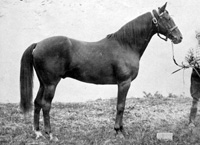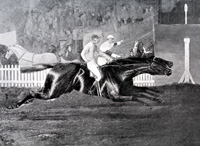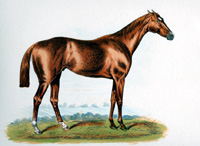|

A Hero of Newmarket

Tristan
and Lucerne run a dead heat for the
1884
Champion Stakes. Painting by John Sturgess


Sire Line

Camel

|
Tristan ch c
1878 (Hermit - Thrift, by
Stockwell).
Sire Line Camel.
Family
10-d. On this one-hundred-and-twenty-fifth anniversary of the
Champion Stakes perhaps we could recall the achievements
of one of the great winners of this historic race. One
of the unsung heroes of the turf, you will find his name
time and again, locked away in the fading pages of the
ancient Racing Calendar. His record of twenty-nine
victories from fifty-three starts, going unplaced only
six times (one of these on account of a disqualification
owing to his jockey failing to weigh-in), is likely to
be equalled or bettered by few in our time.
Tristan
was bred near Dunmow at the Easton stud of Francis Erskine, 4th
Earl of Rosslyn, who was also the breeder of St. Serf. Later
owned by Monsieur C J Lefevre of Haras de Chamant, and trained
by Tom Jennings at Phantom Cottage, Newmarket, the
high-spirited, bad-tempered, Tristan was indeed a giant among
racehorses. A son of the sensational 66-1, 1867 Derby winner,
Hermit, who was himself one of the great sires of the nineteenth
century, Tristan was as durable and tough as his sire was
delicate. And whilst he had inherited what could only have been
described as a vicious temper, he also inherited great courage
from his sire.His
two-year-old career was promising enough: four wins from eight
starts, and only once unplaced. In Ascot’s New Stakes he
finished second, with Iroquois, who was to win the Derby the
following year, behind him.
Owing to a
severe injury, sustained in his last race of the season, he was
not seen on a racecourse in his three-year-old year until the
Two Thousand Guineas, and without the benefit of a proper
preparation, he ran unplaced. He was also unplaced in the Derby,
and it appeared to be another sorry tale of a promising
two-year-old failing to train on.
But if
this was disappointing, we had reckoned without the mettle of
Tristan, and possibly the skill of Tom Jennings, who somehow
cajoled the very best out of his tempermental child. He captured
the Prix de Deauville at Longchamp, and three days later went
down by only a neck in the Grand Prix de Paris to the great
American horse, Foxhall, reckoned by many an astute observer to
be a far better horse than Iroquois. He did after all win both
the Cambridgeshire and Cesarewitch that year.
It was as a four-year-old
that Tristan blossomed, winning eleven races, including the
Epsom Gold Cup, the Ascot Gold Vase, the Hardwicke Stakes and
the July Cup, under the massive weight of 9st 13lbs (139
lbs). It was then off to France again, and a resounding success
in the Grand Prix de Deauville under the back-breaking weight of
10st 6 lbs (146 lbs). He then shared a victory in the
Champion Stakes with the superb filly, Thebais, who was of
similar breeding to Tristan, being by Hermit out of a mare by
Stockwell, and who had won the One Thousand Guineas and the
Oaks. His performances earned him top weight in the
Cambridgeshire, but after a hard season he ran unplaced. This
was no disgrace – Tristan had redeemed himself.
These days, approaching
five years of age, Tristan would have been considered to be past
his best. He may have been summoned to give one final
performance, perhaps at Ascot or Longchamp, and then, almost
certainly, hustled off to stud. But in those far off days
Monsieur Lefevre knew better. As far as he was concerned Tristan
was not finished, yet. He opened his account with a win in a
Royal Plate at Epsom, and then under 10st 6lbs (146 lbs)
failed by only a length to give three pounds to the great Barcaldine in the Westminster Cup at Kempton Park. This would
have broken the heart of many a good horse – but not Tristan.
He came back to win the Epsom Gold Cup for a second time, and
then in his finest hour, defeated the St Leger winner, Dutch
Oven, in the Ascot Gold Cup, when it was the zenith of a great
stayer's career. Two days later he won the Hardwicke Stakes
for a second time, and then it was off again across the Channel
for a second win in the Grand Prix de Deauville, this time
carrying 10st 11lbs (151 lbs). Despite his malevolent
behaviour his appetite for racing never waned. Before the season’s
end he ran three more times, adding another Champion Stakes to
his record.
Surprisingly,
he was called upon to turn out again the next season – in his
sixth year. And what a start, in what was beyond the autumn of
his racing career. His first race would not be a race,
officially, but a trial held at Newmarket’s Second Spring
Meeting. A trial against a three-year-old whipper-snapper, to
whom he was set to concede 23 lbs. A reasonable difference.
After all, you didn't want to give the young'un too hard a
time against a fellow of Tristan’s ability.
Who was
this whipper-snapper who was to put six lengths into the mighty
Tristan, at the post? Ah, yes. Whipper-snapper, indeed. When
they met again a few weeks later, in the Ascot Gold Cup, on the
same terms, the whipper-snapper increased this more than
three-fold, to twenty lengths. Was St. Simon the greatest
racehorse the world had ever seen? Well, certainly one of them
– and certainly one of the greatest sires.
This
thrashing in no way diminished Tristan’s record – more an
elevation of the amazing ability of St.Simon. But to Tristan it
did not matter. Two days later his reputation was restored, with
a third win in the Hardwicke Stakes, followed by a third win in
the Grand Prix de Deauville, again carrying 10st 11 lbs (151
lbs). His farewell to the racecourse (you can imagine the
cheering on Newmarket Heath) was in the Champion Stakes, again
sharing a victory, this time with Lucerne.
His racing days finally
over he was retired to stud at Chamant in France. According to a
scribe of the period he was a racehorse all over, and perhaps
one of the best models ever seen. By his build, his quality, his
staying powers, and his pedigree, the French had a very valuable
stallion. Standing a shade under 15.3 he had a tremendously
powerful build, an enormous depth of chest and very strong
loins; his bone and muscular system were developed in an
extraordinary way that gave the impression of great strength. He
had splendid shoulders, and superb hocks, large, solid bone and
good feet. There was undoubtedly something of the wild animal
about him. When walking in the paddock, he would often stop and
look round like a lion, in a way that did not show a kindly
temper.
He was re-imported to
England in 1891 by Caroline, Duchess of Montrose, to replace
Isonomy who had died that year, and stood at the Sefton Stud
where he got the Oaks winner, Canterbury Pilgrim, herself
possessing the self-same churlish behaviour. She became one of
the influential brood-mares of the twentieth century, being the
dam of Chaucer and Swynford. It is through her that his name
lives on. If you look far enough back into the pedigree of
Sadler's Wells, you will see seventeen crosses of Tristan.
Surprisingly,
perhaps because of his bad temper, he was unfavoured by English
breeders and shortly after the birth of his famous daughter he
was sold to Austria. Tragically, after only three years in
Austria, he became a victim of his own malevolence. In a fit of
violent temper, for no apparent reason, he smashed his head
against the wall of his box, killing himself.
When it
came to racing he was possessed of all the great qualities that
are admired in the thoroughbred. Even in an age of
non-specialisation his versatility was exceptional; he possessed
remarkable stamina, being able to sprint, and carry
back-breaking weights. His courage was beyond question. Never
did he give anything but his all. Although the record books may
prove otherwise, he would appear to be the only horse ever to
win three major races in three consecutive seasons, and
certainly the only horse to have won the Champion Stakes on
three occasions.
He was, no doubt, one of
the greatest of his kind since Lord Salisbury and the Marquis of
Buckingham raced their horses on Newmarket Heath almost four
hundred years ago, and is deservedly woven into the Heath’s
rich tapestry. Perhaps if one has enough imagination, as the
field is summoned to the starting gate, you will see Tristan
with Archer, or possibly Webb, in the blue, white and red of
Monsieur Lefevre passing in the parade. As the runners make
their way into the distance, somewhere down there, where the
Iceni wheeled their chariots against the Romans, the fading
vision finally dies, leaving but the memory of the mighty
Tristan – truly a hero of Newmarket.
© Anthony Byles
| Tristan |
Hermit |
Newminster |
Touchstone |
| Beeswing |
| Seclusion |
Tadmor |
| Miss
Sellon |
| Thrift |
Stockwell |
The Baron |
| Pocahontas |
| Braxey |
Moss
Trooper |
| Queen
Mary |
|
| Notable
Offspring |
| |
| Arouya (b f 1891), 3rd dam of Ratibor-Rennen winner
Mischief (br c 1911 Saphir), 4th dam of Henckel-Rennen winner
Monfalcone (br c 1921 Ariel), and 5th dam of Oesterreichisches
Derby winner Pfalzer Wald (b c 1946 Cirano). |
| |
| Catherine
(br f 1888), 6th dam of Gran Premio Nacional winner Anacoreta
(br c 1947 Tandem). |
| |
| Fine
Mouche (ch f 1889), 2nd dam of Prix du Jockey Club winner
Finasseur (ch c 1902 Winkfield's Pride), 2nd dam of Prix de
Diane winner Marsa (ch f 1907 Adam) and Prix la Rochette winner
Marka (b f 1910 Ajax), as well as ancestress of numerous other
good winners in central and eastern Europe. |
| |
| Fortuna
(ch f 1889), sent to South America and there ancestress of
Premio Ignacio Correas (twice) winner Emilunga (ch f 1904
Millenium), Gran Premio Nacional winner Tamesis (ch c 1930 Le
Coeur), Grande Premio Derby Paulista winner Vatapa (ch 1939
Violator), Gran Premio Nacional winner Zumbador (b c 1957
Hidalgo), and others. |
| |
| Ma
Belle (ch f 1895), 3rd dam of Phonix (ch c 1927 Pazman),
winner of Graf Hugo Henckel Memorial, Oesterreichisches Derby
and Millennium dij, 5th dam of Matador (b c 1949 Brancas),
winner of Derby Roman, and ancestress of many other good winners
in central and eastern Europe. |
| |
| La
Nievre (ch f 8191), 4th dam of Polla de Potrillos winner De
Bono (b 1935 Omer Emeth). |
| |
| Le
Nicham (bbl c 1890), won Champion Stakes, Woodcote Stakes
and Poule d'Essai des Poulains. |
| |
| Le Nord
(ch c 1887), won Dewhurst Stakes, Prix de la Foret. |
| |
| Mary
Hamilton (ch f 1893) dam of Irish Oaks winner Mary Lester
(ch f 1900 Lesterlin). |
| |
| Regina
(ch f 1889), sent to South America where she was ancestress of
numerous winners, including Premio General Belgrano winners La
Natita (b f 1911 Old Man) and Respingo (b c 1941 Alan Breck)
as well as the good stallion Pipiolo (b c 1907 Orange). |
|

